
The Temple of Literature in Hanoi
- on Nov 13, 2020 By: Ngoc Nguyen
Van Mieu - Quoc Tu Giam, rich in its enormous value in many respects, cultural, historical and aesthetic, this heritage represents the quintessence of Vietnam's thousand-year-old cultural traditions of education and the development of talents.
A thousand-year-old history
Charming and original architecture
This complex, which covers a total area of 54.331 metres, is made up of three main parts: Lake Van (Ho Van), Giam Garden (Vuon Giam) and Interior (Noi Tu), surrounded by stone block walls.

Panorama of Van Mieu - Quoc Tu giam
At the main entrance stand four grandiose columns (Tu tru), two of which are nicknamed "Ha ma" meaning "to get off the horse". Then there is the large portal Van Mieu mon. On two sides of the steps stand two stone dragons as guardians whose artistic style is typical of the Nguyen dynasty.
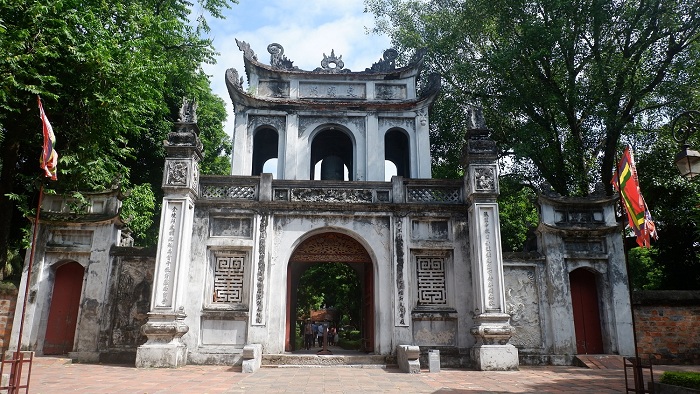
Van Mieu mon portal
The Interior is divided into five large consecutive courtyards:
- The 1st or “Nhap dao” (Moral Initiation), extends from the Van Mieu portal to the Dai Trung (Great Middle) portal which is covered with a tiled roof, with two side doors on the right and on the left, Thanh Duc ( achievement of Virtue) and Dai Tai (achievement of Talent).
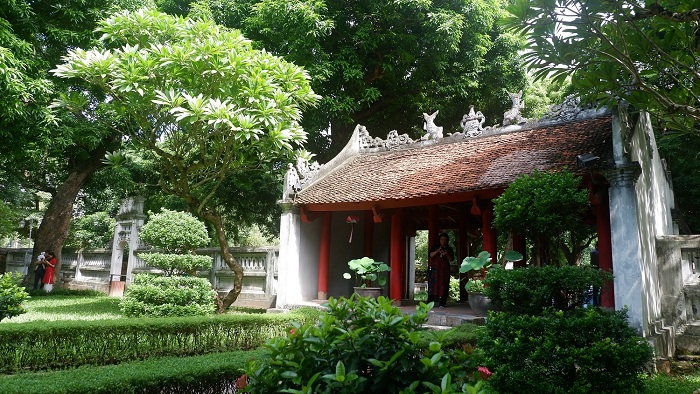
Dai Trung Portal (Great Middle)
- The 2nd or "Thanh dat" (Success), stretches from the Dai Trung portal to Khue Van Cac or Constellation Pavilion of Literature, a typical architectural monument that symbolizes the history and culture of Hanoi. This Pavilion, built in 1805, consists of 2 floors. At the bottom, there are 4 brick columns and, at the top, wooden structures whose four facades each have a round door. The roof is covered with tubular tile. On two sides of the Pavilion are the side doors Bi van and Suc van, whose name evokes the beauty of literature.
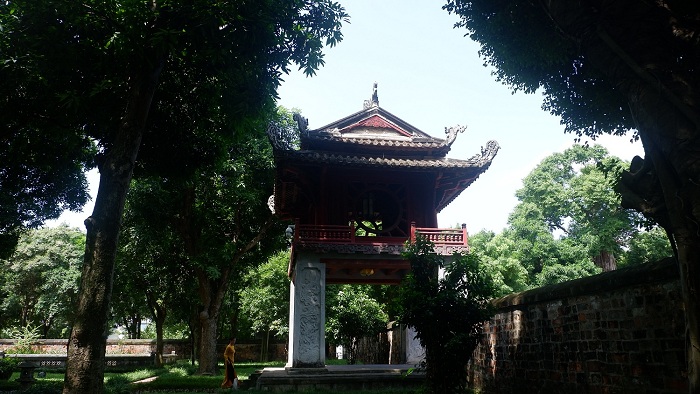
Khue Van Cac or Pavilion of the Constellation of Literature
- The 3rd courtyard, the Thien Quang well (of Celestial Clarity) is located in the middle of two symmetrical buildings on which we admire the 82 headstones of the Doctors, erected on the backs of stone turtles, between 1484 and 1780. Next to the Dai Thanh gate which leads to the 4th courtyard, there are two small entrances, Kim Thanh mon and Ngoc Chan mon.
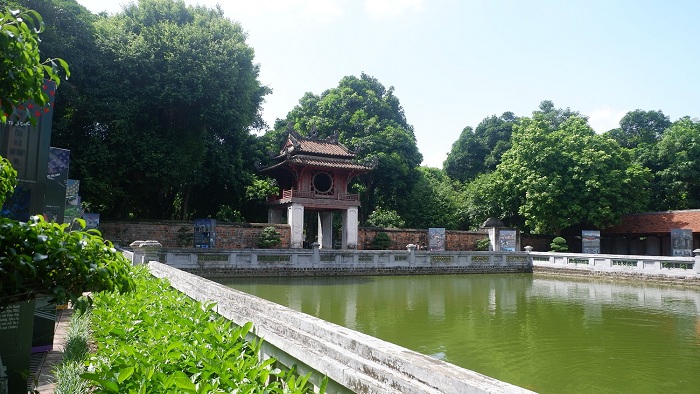
Thien Quang Well (of Celestial Clarity)
- The 4th courtyard (Dai Thanh Dien), where there are two buildings Ta vu (Left) and Huu vu (Right), dedicated to the commemoration of the 72 elite disciples of Confucius and Chu Van An, great cultural man of the world, prominent educator under the Tran dynasty. In the middle of the courtyard is “Bai duong”, a sacred place dedicated to ceremonies, where ancestral tablets dedicated to the 10 senior sages are displayed, parallel calligraphies and sentences saluting Confucianism, its founder and his four excellent disciples “Tu phoi” , Nhan Hoi, Tu Tu, Tang Sam and Manh Tu.
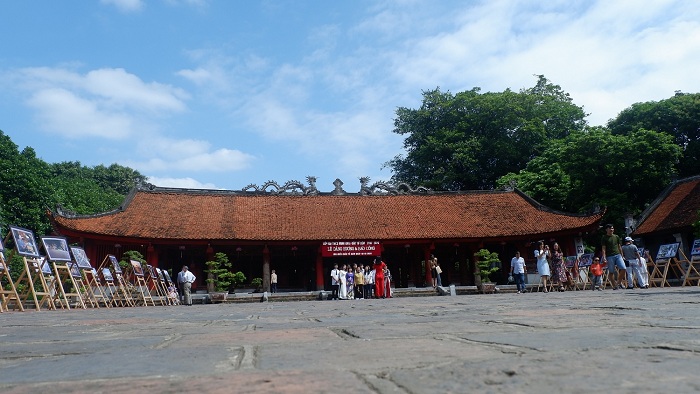
Thai Hoc House
- The 5th courtyard overlooks the Thai Hoc house which sits in front of the former Quoc Tu Giam, Vietnam's first university. At the start of the 19th century, under the Nguyen dynasty, Quoc Tu Giam was reorganised in Hue, in the centre of the country. This house was transformed into a Khai Thanh temple dedicated to the parents of Confucius.
The monuments of Van Mieu can be identified by bricks and tiles, characteristic of the style of the Le and Nguyen dynasties. The gardens are embellished by centuries-old trees and small lakes as calm as they are picturesque.
The 82 headstones of the Doctors - world documentary heritage
Located in the middle of Van Mieu is Vuon Bia (Garden of Headstones) which starts from Khue Van Cac to the Dai Thanh gate. In the center of the garden is a square lake nicknamed Phuong tinh. After the aisles there are majestic headstones which divide into two suites to the east and west. The total number of 82 headstones bears the name and origin of the Doctors (including 81 belonging to the Le dynasty and one of the Mac dynasties). These works are revealing not only the great figures of venerable historians of the country but also of diplomatic relations between the countries of Southeast Asia.
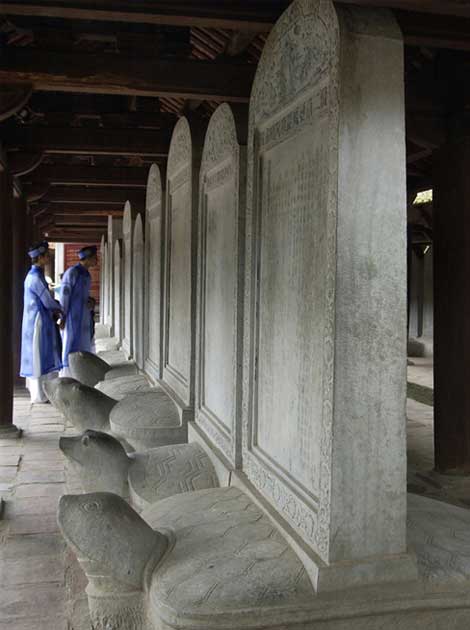
The Doctors' headstone
To quote in particular the historian Ngo Si Lien, winner of the doctoral competition in 1442, the author of the work Dai Viet su ky toan thu (historical encyclopaedia of Dai Viet), the scholar Le Quy Don, laureate in 1752, the author of many important works including the Dai Viet thong su (dictionary of the history of Dai Viet), the great politician and diplomat Ngo Thi Nham, laureate in 1775, adviser who helped King Quang Trung in the glorious battle Ngoc Hoi - Dong Da against the Chinese enemies of the Thanh.
Of the 1304 Doctors honoured on these 82 headstones, 225 were sent to China as ambassadors during the Minh (1368-1644) and Thanh (1644-1911) dynasties. In particular, Le Quy Don (1726-1784), during exchange missions to Korea and China, was greatly appreciated by their scholars for his great knowledge of letters.
An abundant documentary collection spanning over 300 years under the Le and Mac dynasties, the Van Mieu Headstone presents a vivid illustration of Vietnam's original system in terms of recruiting and training talent. This brings out the spirit of the national administration based on the development of talents, constantly forged over the centuries.
Moreover, the kings of Le and Mac all adopted the philosophy of Confucius as a guideline for the education and selection of national elites. To do this, two primordial criteria "Morality" and "Talent" were privileged and the filtering rested a priori on the imperial competitions.
"Talent is a national resource, the guarantor of national prosperity" this spirit is firmly reflected from the creation of the first stele following the royal competition of 1442. The following ones dating from the years 1556, 1604, 1703, 1763 and 1772 have all stressed the importance of work "to cultivate and develop talent."
It should be noted that the value and originality of these 82 headstones lies in the sculptural content. Certainly, the erection of headstones is done in several countries, but only those in Van Mieu display the history of competitions and the philosophy of the dynasties on education, training and the development of talent.

World documentary heritage recognised by UNESCO
The contents are all transcribed in Chinese but in different styles, hence the fact that each stele is itself a calligraphic work. You can always see characters and content such as date, name of author of content and construction. These carved traces as well as the architectural style of the headstone and the turtle are characteristic of their time and vary according to it. These works, normally the fruit of great men of the country, are truly invaluable works, emblematic of Vietnamese culture and tradition.
The 82 Doctors' headstones were inscribed in March 2010 by UNESCO in the “Memory of the World, Asia-Pacific region” register and recognized in July 2011 as world documentary heritage by UNESCO.
The Temple of Literature has in the past played a primary role as a shrine to Confucianism, as well as education and the promotion of national talent. Recognized in May 2012 as a special national vestige, this ensemble continues to be an imperishable emblem of Vietnamese cultural evolution and which makes Hanoi a "thousand-year-old pearl of culture" of the country. Nowadays, Van Mieu - Quoc Tu Giam stands out on the one hand as an essential part of the cultural heritage of the capital, and on the other hand as a high place where important cultural events such as scientific seminars are organized, such as specific exhibitions, ceremonies honouring excellent university graduates, State Professors, reading rooms, and National Poetry Day.
Related articles:
Comment
Other Blog
Categories
Latest News
on 31 Dec, 2025
on 31 Dec, 2025
 Español
Español Français
Français






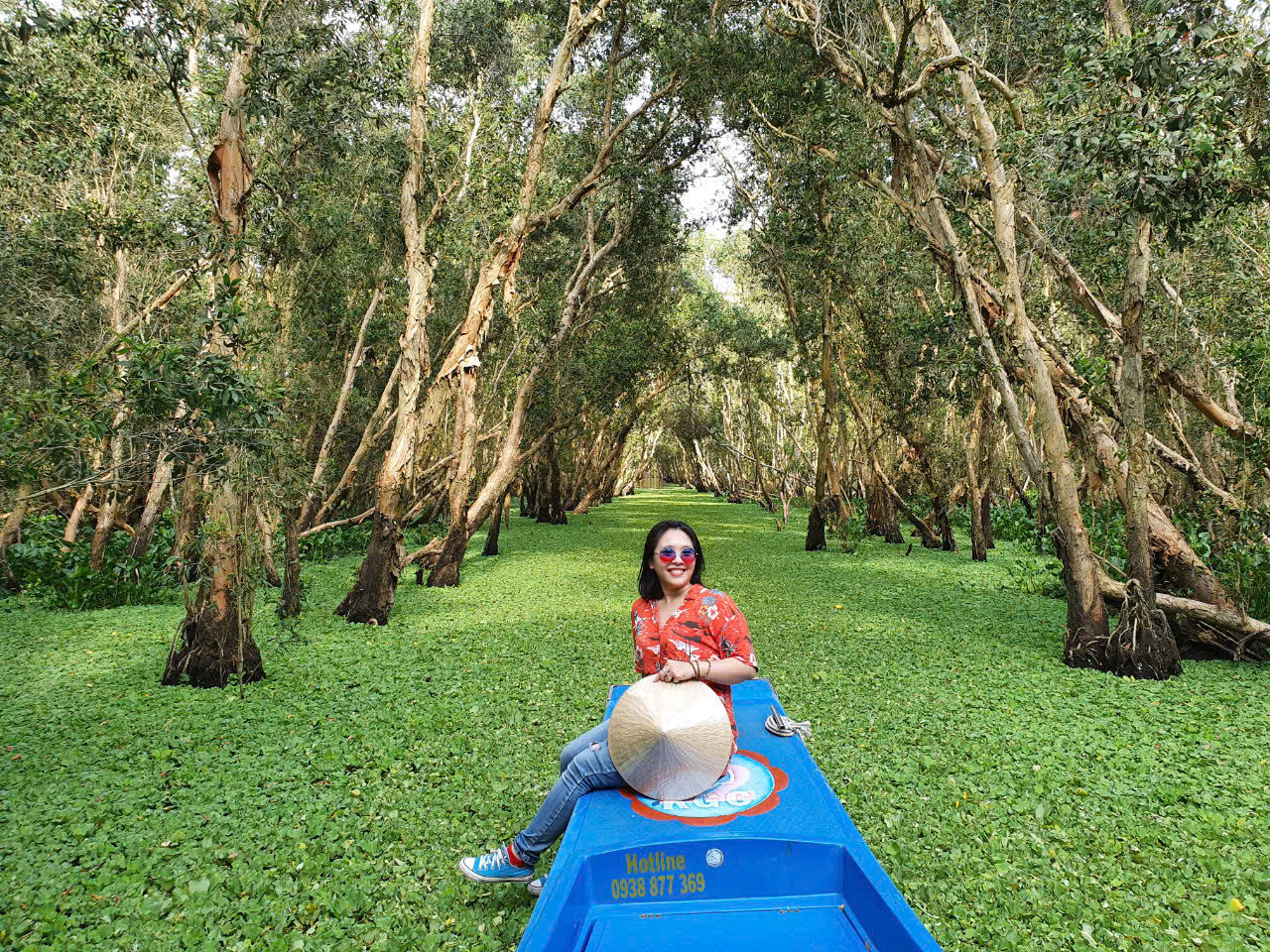
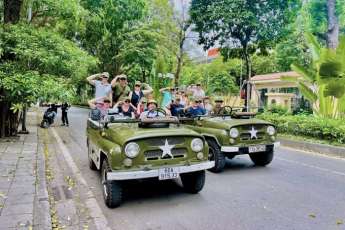

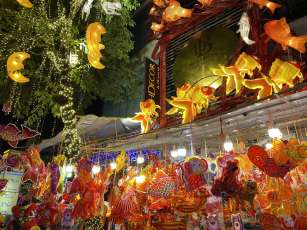










Morgane Ter Cock
on Dec 18, 2025HerbertPhomaMS
on Oct 19, 2025Lilyan Cuttler
on Oct 15, 2025Avenue17XC
on Sep 14, 2025Avenue18JL
on Jul 21, 2025